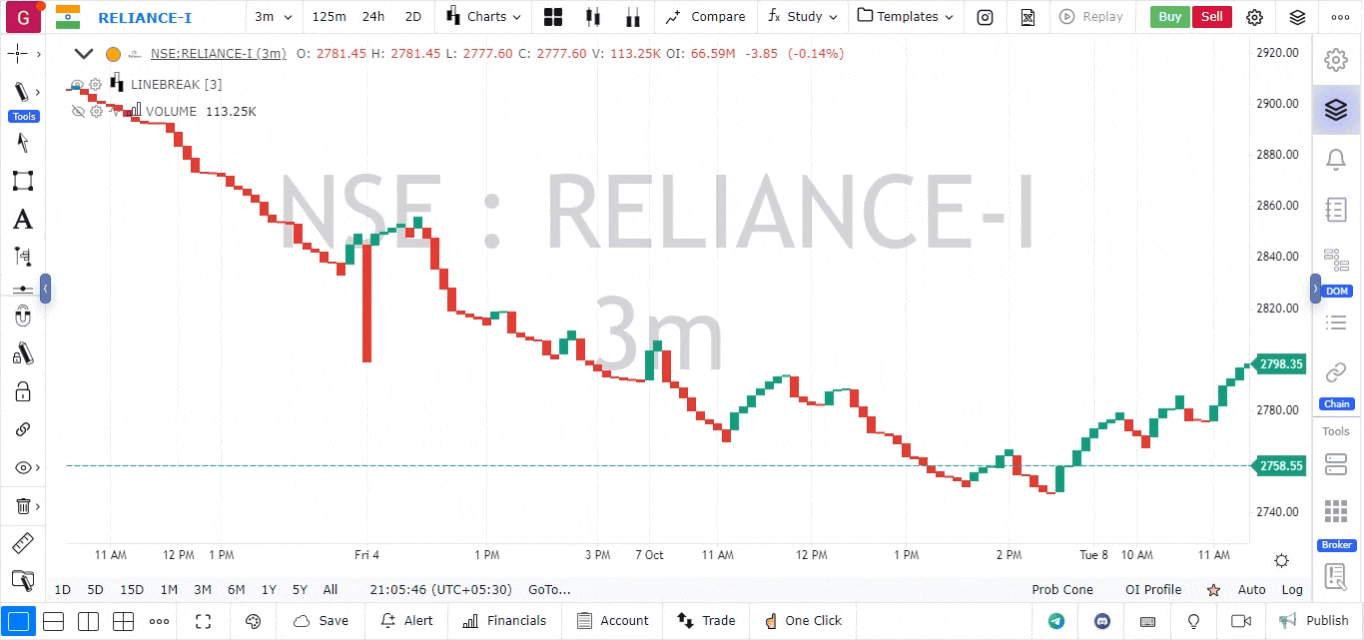Kagi
General info
Time intervals are completely cast aside as Kagi Charts only take price action into consideration. The word Kagi is derived from the Japanese art of woodblock printing. A Kagi or Key is an L-Shaped guide used to properly align paper for printing. Due to this, Kagi Charts are even sometimes referred to as Key Charts. The premise of Kagi Charts is fairly simple. Essentially, from the starting point (usually the first closing price), lines are drawn solely based on price action. The Up Lines (also called the yang lines) are formed during uptrends, while Down Lines (yin lines) are formed during downtrends.
As PnF chart and Range bars, Kagi chart is fully time-independent and based on price action only. Kagi chart consist of vertical lines that connected by horizontal lines.

Kagi chart in the platform
As long as prices continue to move in the current direction, the current up line or current down line will continue. Once price reverses enough (the necessary reversal amount is set by the trader), a horizontal line is drawn and then a line is drawn in the opposite direction of the previous line, stopping at the new closing price.
Line types
There are five different types of lines that can be drawn within a Kagi Chart.
- Up Lines (Yang Lines) — Form during an uptrend.
- Down Lines (Yin Lines) — Form during a downtrend.
- Projected Up Lines — During an intraday timeframe, a potential up line that would form based on current price (before actual closing price is set).
- Projected Down Lines — During an intraday timeframe, a potential down line that would form based on current price (before actual closing price is set).
- Horizontal Lines — Lines drawn when a line changes direction. When an up line changes to a down line, the horizontal line is considered a shoulder. When a down line changes to an up line, the horizontal line is called a waist.
Line calculation methods
GoCharting Kagi Charts use following methods:
Average True Range
- The price movement thresholds are determined by a prior 14-day ATR value from the current price level (at the time of chart activation). The upside to using the ATR method is that it auto adjusts the price levels depending on the symbol and its corresponding True Range
Fixed Price
- Absolute values to determine line reversals. A price movement in the direction opposite of the current line, that exceeds the user defined reversal value, will cause a horizontal shoulder or waist to form along with a new line. The upside to using absolute values is that it is very straightforward and it is easy to anticipate when and where new lines will form. The downside is that selecting the correct reversal value for a specific instrument will take some experimentation.
ATR Persistence
- The ATR Persistance method is a dynamic method where the price level changes across candles depending on a rolling 14- day ATR value whichauto adjusts for historical volatilities and price movements
GoCharting as a platform allows you to plot a Chart on Chart. For example, in the Source field we can choose from a variety of parameters including other the Heikin Ashi chart close
Uses of Kagi Charts
Kagi Charts are a popular charting choice because of their ease of interpretation. Because they do not take time intervals into consideration at all, they have a way of factoring out the associated noise. When price movement is the only variable that matters, the creation of new lines gains importance. Price movements typically need to be substantial to register a line change and therefore should always be noted. Natural, small price variations that occur naturally over time can therefore be disregarded. Some common, everyday applications for Kagi Charts are basic line reversal trading signals, support and resistance discovery and a sequence-based reversal pattern.
Up Line/Down Line Reversals — Steve Nison, who brought popularity to Kagi Charts, offered the most basic interpretation of the charts. It is simple, buy in yang, sell in yin. Basically, buy in a reverse to an up line and sell in a reverse to a down line.
Support and Resistance — Oftentimes, Kagi Charts reveal areas of support and resistance.